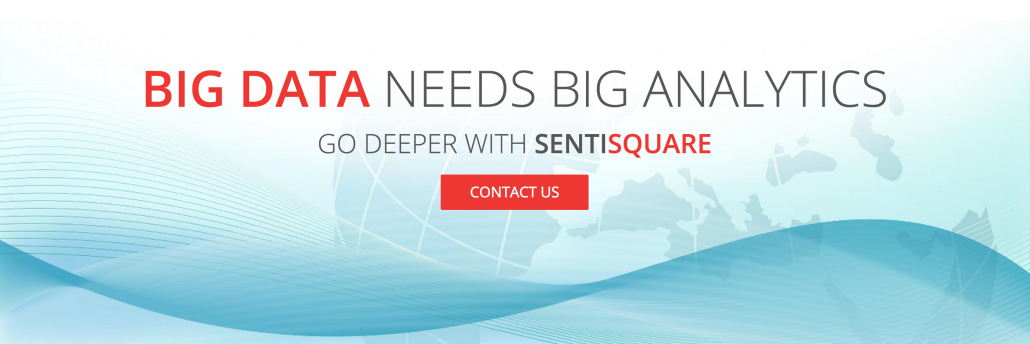SentiSquare: Big Data Means Big Mistakes for Brands
Last week, I sat down with Founder and CEO of StartupYard 2014’s SentiSquare, Josef Steinberger, to talk about how the company took 3rd place among 72 challengers at the UPC: Ignite innovation competition, and what SentiSquare has been working on since leaving the accelerator last year.
 Hi Josef, how have things been going with SentiSquare since you left StartupYard in 2014?
Hi Josef, how have things been going with SentiSquare since you left StartupYard in 2014?
Wow, has it been 18 months already? We have been quite busy, and we’ve signed a few really high-profile clients, including Nestle and T-Mobile in the Czech Republic.
Our most exciting recent news is that we took 3rd place in the UPC competition: Project Ignite, which is for the best tech entrepreneurs in the country. We took 100,000 CZK (about 4,000 Euro), which we plan to use on further development of the SentiSquare service.
How did you get involved with the UPC contest?
Stanislav Rejthar, our financial director, is quite well connected to business in Prague, and he found out about the competition, so we decided to enter. There were 72 projects in the 1st round, with 30 semi-finalists, and 11 finalists. Five finalists passed to finals from the Facebook voting and 6 were selected by jury. And we took third place overall.
The first place winner, this is a bit funny, but they are actually working on turning pig-dung into water and other nutrients. So we got beat by pig shit :laughs:. But we were really happy with the results, and the upside is that UPC has expressed a lot of interest in working with us going forward.
Can you talk a bit about how you can help companies like Nestle, T-Mobile, or UPC, without talking about the specifics of those clients?
Sure. What we do, as you know, is a sentiment analysis across the whole web. This means that we are able to tell our clients in good detail, what their customers are talking about, and how they feel about those topics and specific things they discuss. We get this info from social media, forums, websites, and comment sections that number in the 100s of thousands and more.
So, for example, we are able to tell a large name brand that is about to launch a marketing campaign based on a specific topic, what people are already saying about that topic, and the feelings of consumers related to that topic. And we can give this analysis in much more detail than simply: “good or bad.”
In fact, one of the reasons we start working with the brands even before the campaign starts, is that we can help them to shape the nature of the campaign to get a better response. We can tell them what their consumers are likely to respond to, and it works.
Can you give me an example of how that works?
Yes. For one client, we worked with them on launching their company blog. This was a pretty large brand. They wanted to launch their blog in the new year, attracting people who were interested in new year’s resolutions and this kind of thing.
So, the company had a list of topics that they thought people would be searching for on Google, which they could take advantage of by writing about those topics, in relation to their own products. What we found, though, was that there were a number of topics being discussed quite a lot related to new year’s resolutions, but involving topics that were not included in the campaign’s key word targets. It happened, however, that these topics were very relevant to the company, and that PPC prices for these search terms were a very good value for the price.
So we were able to identify, among the company’s core demographic, a topic that was not being served, and allowed them to have a very good search position for those terms.
We did more than just help the company understand what people liked and didn’t like, but also things that the company had no idea they were talking about at all. That was a big advantage for them and they saw the results in their search traffic and ROI for that campaign.
Are big brands surprised by what you tell them?
All the time! Marketers and managers like to have very clear and precise information, that they can sort of divide into yes/no decision processes. So, for example, they want a clear yes/no answer to the question: “is my campaign working?” But what we are always showing them is that these questions are more complicated than they want to make them. And in that complexity lies a lot of opportunities that are not being taking advantage of.
For example, a big brand might say that a campaign is a “success,” if people are talking more about their brand after the campaign than before. That is easier to measure also. But campaign managers can’t tell whether people are talking about the actual messaging of the campaign. They have to assume that more people talking about the brand or product means the messaging is working, but it might not be. Even if they use simple positive/negative sentiment analysis, they can’t tell why people feel positively or negatively. They can’t tell if the message is working as intended.
We can help brands determine if people are talking about the messaging that the brand is using, and this can give a much better sense of whether the campaign is a success. We can also do pre-analysis to understand whether the intended audience will be receptive to that message, and if not, to what messages they might be more receptive.
How do big brands currently determine what their campaign messages should be?
It’s mostly about intuition. Some big companies literally have someone going through thousands of customer posts on social media and forums, and trying to glean some kind of insight about what customers are interested in. So it is possible to get a subjective, intuitive sense of what is important to your customers. But it is very difficult to get an objective, provable figure to support that intuition.
On the other side, it is relatively easy to analyze the sentiment of your brand’s audience in positive/negative terms, but that doesn’t help you at all to understand what your messaging should be. Even positive/negative terms are super-subjective. They are down to culture, to context, to the type of person talking, and the person they are talking to. A human can recognize sentiment when we see it, but it is much more complicated to see sentiment in the aggregate. It is very easy to think you understand it, when you really don’t.
We are providing a kind of intuition engine. It has the reach of a large scale data tool, but it can provide the subtlety in insights of a human.
So you help companies to avoid false positives in sentiment analysis?
False positives or also completely wrong assumptions about data.
There is a really funny example we experienced recently. We were doing analysis of the wine industry. The customer had already had another company scrape a large amount of data including basic search terms, such as the word “wine” and its variants in Czech. They wanted to see what kinds of wine people were talking about in a one month period. So far so good.
Now, you can do a broad sentiment analysis based on positive or negative keywords, and give some impression of whether people have good or bad associations with certain types of wine, right? Well, not in this case. Our analysis was able to show that a huge amount of this data (about 80% actually) was totally useless. Why? Because it wasn’t about wine! It was about cars.
Cars?
Yeah, cars. The data scraping had caught a lot of information about VIN numbers (vehicle identification numbers). It had also scraped a lot of information about Vin Diesel, the actor. Wine, in Czech, is written as vino, or vin, or some variation. So without our analysis of what the subjects actually being discussed really were, the client might have made a lot of really wrong assumptions about what people feel about different wines. You think a lot of people like red wine, but they really like red cars! Or maybe they say they love wine, but they are really fans of Vin Diesel movies.
The data would be worse than useless. It would cause you to make all kinds of wrong assumptions about your audience.
But we were able to pre-process that data, and make the final data set much more valuable for analysis.
You said earlier that you can give more than a black and white look at customer sentiments? How do you do that?
There are a few ways.
One of the problems with sentiment analysis for large amounts of written text, is that there are a lot of positive and negative keywords mixed together. It doesn’t make sense just to count them up, because the actual construction of thoughts is not so binary.
So what we can do is to provide a sense of the intensity of sentiments overall. Is a customer generally happy, or generally unhappy? A customer can use a lot of negative words, but still be mostly satisfied with a product. Some people just enjoy complaining, and a brand shouldn’t count that person as an unsatisfied customer. So we can provide this shading of sentiment by intensity.
There is also aspect based sentiment analysis. This is the analysis of not just a brand as a whole, but as related to specific aspects of the brand and its products. Maybe people love a brand, but they have negative sentiments about its prices. Or the opposite can happen. Maybe they love the functionalities, but hate the color. By combining these insights, we can present a much more realistic picture of a customer than simply: like/dislike.
How are you different from other monitoring services like BrandEmbassy (also a StartupYard Alum)?
BrandEmbassy provides monitoring of keywords, which allows service representatives to see live conversations on social media and elsewhere. The big advantage for them is that they can route those conversations to the appropriate person on their team and engage directly with the customers.
What we do is the eagle eye view of all those conversations- we can tell companies what the totality of all those conversations really means. So it has a bigger effect on a company’s overall communication and branding strategies, whereas a company like BrandEmbassy helps a company to improve its small-scale interactions with individuals.
What are your plans for the near future?
A big request is for our system to be available in real time. This is something that we really want to develop more in the near term. Having the ability to see the conversation changing online at every moment, and being able to understand how people feel about things from day to day, is an important thing for big brands.
As conversations online get only more numerous and also more specific, the job of keeping up with that volume is getting unmanagable for the biggest brands. SentiSquare can provide a pulse of conversation that really provides valuable insights, even in the day to day. Brands can use SentiSquare to get an evolving list of important keywords that are related to their brands.
That list changes every day, but currently it takes a long time for that information to filter into a brand’s messaging. Given the prioritization on the topic or opinion level, brands can quickly get a gist about the actual situation The speed is important, because all the brand managers are busy people. We can make them more responsive to the conversation of today.
We want to change the way people look at sentiment analysis. Things are not black and white, positive and negative. Somebody says something is “big.” What does that mean? It’s not good or bad in all cases. Nothing in discourse is cut and dried, and all sentiments have levels of intensity.
Our clients usually want black and white answers. We have to educate our customers about the danger of viewing their brands in this way. The magic answers that big data is supposed to provide can easily be very wrong. And we can help companies identify opportunities they are ignoring, because they have been addicted to this positive/negative polarity.





